You may tap or click a photo illustration to see a larger version.
- Anterior:
- Towards the front, or towards the head of the animal.
- Carapace:
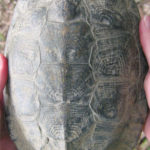 The carapace is the shell that covers the back of the turtle.
The carapace is the shell that covers the back of the turtle.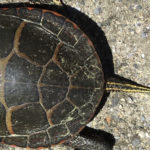 A smooth posterior margin of the carapace.
A smooth posterior margin of the carapace.
(Photo by J. Andrews) A toothed posterior margin of the carapace.
A toothed posterior margin of the carapace.
(Photo by J. Andrews)- Clutch:
- The number of eggs laid in a single reproductive event. Note that the eggs may be scattered as single eggs, laid together in a single group, or in multiple groups (egg masses).
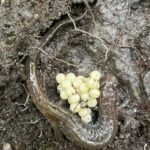 The Northern Dusky Salamander (Desmognathus fuscus) clutch size varies from 5-40 eggs, with an average of 19 eggs per clutch in Vermont. (Photo by K. Kelly)
The Northern Dusky Salamander (Desmognathus fuscus) clutch size varies from 5-40 eggs, with an average of 19 eggs per clutch in Vermont. (Photo by K. Kelly)- Cranial kinesis:
- The movement of skull bones relative to each other. The upper jaw in snakes and some lizards can move away from the brain case to allow ingestion of large prey. See also mandibular liberation.
- Dorsolateral ridge:
- A fold of skin beginning behind the eye and extending part or all of the way to the rear legs on both sides.
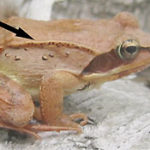 The presence or absence of a dorsolateral ridge can be very helpful in the identification of a frog. (Photo of a Wood Frog by E. Talmage)
The presence or absence of a dorsolateral ridge can be very helpful in the identification of a frog. (Photo of a Wood Frog by E. Talmage)- Field mark:
- A visible mark or characteristic that can be used to help identify a species. It is always worth checking multiple field marks to confirm your identification. Examples of field marks might be presence of dorsolateral ridges, size of front legs relative to back legs, or a pattern or coloration on the body or head.
- Ectotherm:
- Doesn’t generate its own body heat; receiving its heat from external sources. Snakes, turtles, lizards, frogs and salamanders are ectotherms.
- Herptile (“herp”):
- A reptile or amphibian. We exclude avian or endothermic reptiles (birds) when using this term.
- Incubation:
- The time during which eggs, either reptile or amphibian, develop outside the body until the larvae leave the egg (hatch). For some reptiles, eggs may develop in the female’s body before being laid, but the incubation period begins when the eggs are laid.
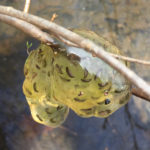 A Spotted Salamander (Ambystoma maculatum) egg mass showing mostly developed embryos that haven’t yet hatched (Photo by J. Salisbury)
A Spotted Salamander (Ambystoma maculatum) egg mass showing mostly developed embryos that haven’t yet hatched (Photo by J. Salisbury)- Larva:
- An organism in a stage of development (usually aquatic) after hatching, but before metamorphosis or sexual maturity. Larval amphibians may look significantly different than they do as adults (for example, larval salamanders have external gills and tailfins, and larval frogs and toads (tadpoles) have tails, and internal gills instead of lungs). Plural: larvae
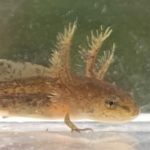 Larval Spotted Salamander (Ambystoma maculatum) showing external gills and a tailfin (Photo by E. Talmage)
Larval Spotted Salamander (Ambystoma maculatum) showing external gills and a tailfin (Photo by E. Talmage)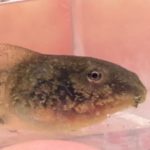 Larval Wood Frog (Lithobates sylvaticus) also known as a tadpole (photo by E. Talmage)
Larval Wood Frog (Lithobates sylvaticus) also known as a tadpole (photo by E. Talmage)- Mandibular liberation:
- The state of having the two lower mandibles (jawbones) not fused together at the front of the mouth; a feature of snakes. This frees the mandibles to stretch apart, allowing the snake to swallow prey larger than than its head. See also cranial kinesis.
- Neonate:
- A recently born (or hatched) animal
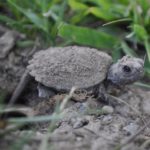 A neonate Snapping Turtle (Chelydra serpentina) emerges from its nest. (Photo by P. Perry)
A neonate Snapping Turtle (Chelydra serpentina) emerges from its nest. (Photo by P. Perry)- Ophiophagus:
- Snake eating. A few snakes (and other organisms) specialize in eating other snakes.
- Oviposition:
- The act of laying eggs.
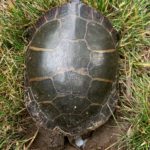 Painted Turtle (Chrysemys picta) laying eggs (Photo by L. Kavanaugh)
Painted Turtle (Chrysemys picta) laying eggs (Photo by L. Kavanaugh)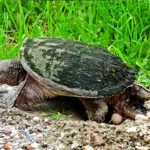 Snapping Turtle (Chelydra serpentina) laying eggs (photo by D. Cockrell)
Snapping Turtle (Chelydra serpentina) laying eggs (photo by D. Cockrell)- Plastron:
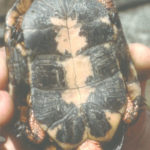 The plastron is the shell that covers the bottom of the turtle.
The plastron is the shell that covers the bottom of the turtle.
(Photo by C. Fichtel)- Posterior:
- Towards the back, or towards the tail of the animal.
- Scales:
- keeled or smooth
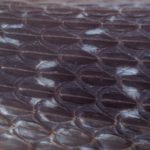 Keeled scales have a ridge along the centerline of the scale.
Keeled scales have a ridge along the centerline of the scale. 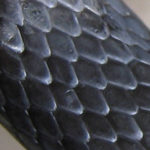 Smooth scales do not have a ridge.
Smooth scales do not have a ridge.
(Photo by J. Andrews)- Scute:
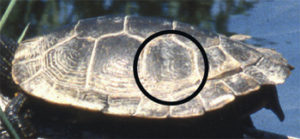 A single plate or scale on a turtle’s shell.
A single plate or scale on a turtle’s shell.- Sexual dimorphism:
- Distinct difference in size and/or appearance between sexes of the same species.
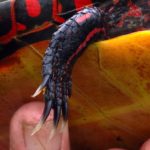 Male Painted Turtles (Chrysemys picta) have long claws on their front legs (photo by S. Morse) …
Male Painted Turtles (Chrysemys picta) have long claws on their front legs (photo by S. Morse) …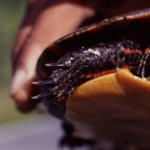 … while females have shorter claws (photo by K. Kelly). Female Painted Turtles are also larger than males and have a shorter tail.
… while females have shorter claws (photo by K. Kelly). Female Painted Turtles are also larger than males and have a shorter tail.- Tympanum:
- The tympanum is the eardrum of a frog and in some species it can be seen very clearly. In the green-faced frogs (American Bullfrog, Green Frog, and Mink Frog) the size of the tympanum relative to the eye can be used to determine the sex of the animal. The males have tympana that are almost twice the size of their eyes. The female’s tympana are about the same size as or only slightly larger than their eyes.
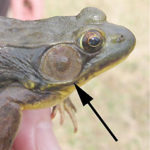 Male tympanum
Male tympanum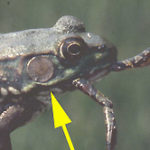 Female tympanum
Female tympanum- (Photo of male frog by E. Talmage; photo of female frog by J. Andrews)

